What Is Golden Syrup And What Are The Best Ways To Use It?
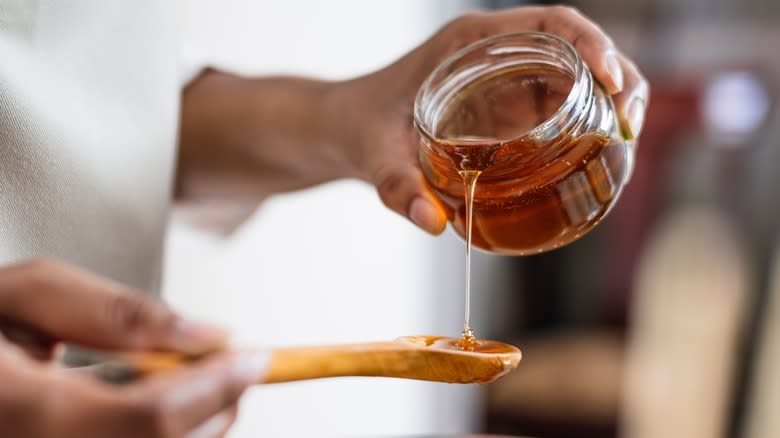
One of the keys to becoming a confident baker and chef is to be comfortable working with and understanding the myriad of different types of sweeteners available that you can use to create various recipes. From cane sugar to honey to maple syrup to agave, each sweetener provides distinct flavor, texture, and properties that make it more or less suitable for a particular dish.
As a chef, I have spent plenty of time studying and incorporating these distinct sweeteners to determine the best ones for various recipes. One such sweetener is golden syrup. You have likely seen tins of this unctuous amber-hued delight if you have ever prepared a recipe from a British cookbook or are an avid viewer of "The Great British Bake Off" show.
Its unique texture, flavor, and aroma make it a favorite in myriad recipes. While many have attempted to substitute it, its original properties make it a one-of-a-kind sweetener with no suitable equivalent. Read on to discover what makes golden syrup so rare, how it is made, how to cook with it, and where you can find it. Once you have mastered this ingredient, you can bake like a professional, too.
Read more: What These Imitation Foods Are Actually Made Of
What Is Golden Syrup?
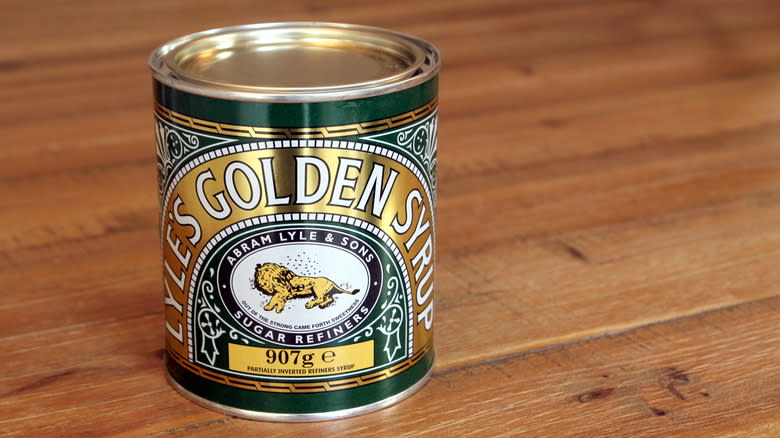
Also known as light treacle, golden syrup began as a by-product of sugar-making. In the late 1800s, sugar had to be refined before being sold in conical slabs, which were further processed into chunks by hand in the homes of British citizens. The process of forming these mounds of sugar yielded a rich, syrupy, caramel-hued liquid that could be further purified through charcoal to produce a sweetener that had distinct qualities.
Scottish businessman and owner of one such sugar refinery in London, Abraham Lyle, quickly saw an opportunity to begin marketing this liquid sweetener he affectionately dubbed "Goldie." What emerged in 1881 was Lyle's Golden Syrup, which has been in continuous production ever since. This syrup has obtained the royal seal of approval, remaining the product of choice for the royal family for generations.
The tin in which Lyle's Golden Syrup is sold has remained the same since 1884, garnering it the Guinness World Record in 2007 for having the oldest consistent brand of any product globally. The image on the tin of this brand bespeaks the religiosity of Mr. Lyle, depicting a lion carcass swarming with hordes of bees, an homage to the biblical tale of Samson. Below the lion is the phrase "Out of the strong came forth sweetness," a reference to the Bible passage from Judges 14:14.
How Is Golden Syrup Made?
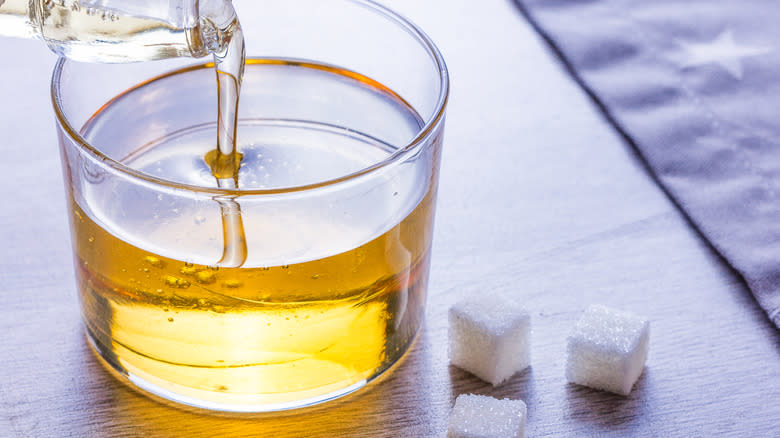
Golden syrup is produced by inverting sugar. This refinement procedure can be done using cane sugar or sugar beet juice. Inverted sugar is a term that describes breaking sucrose down into its simple sugar components, fructose, and glucose. This is accomplished by incorporating water and acid into the sugar. The water dissolves the sugar, while the acid is the catalyst for breaking the sucrose into its base components.
The resulting syrup is caramelized during this process, giving it its unique color and almost savory flavor. It is approximately 25% sweeter than sugar and relatively neutral in PH, making it favorable over regular sugar since it does not influence the acidity of a recipe in a notable way.
Golden syrup can be easily made at home by combining water with equal parts brown and white sugar in a saucepan over medium heat. Once the sugar has dissolved, citric acid or lemon juice gets added to the mixture and simmered undisturbed for about 40 minutes. The result should be relatively viscid and have a deeper amber hue. Once cooled, the golden syrup is ready for use in recipes.
What Does Golden Syrup Taste Like?
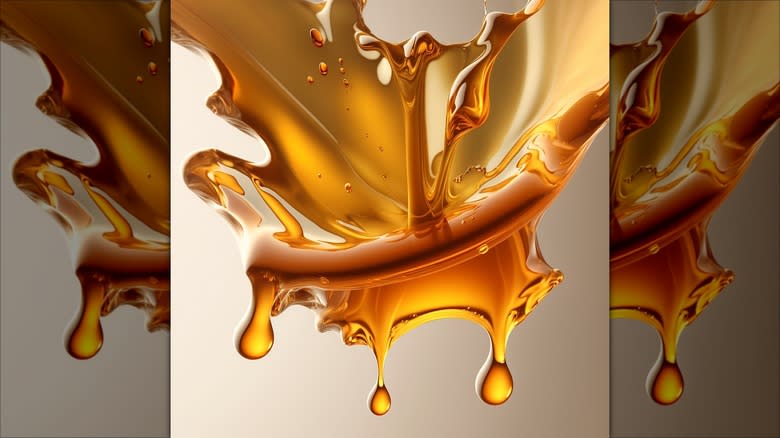
Golden syrup is distinct because it remains liquid at room temperature, which gives it an advantage over granulated sugar in myriad recipes. It is differentiated further by its flavor. Even though this syrup is vegan, it has a savory richness that gives the illusion of it containing butter. It is often compared to caramel and is far sweeter than conventional white sugar.
Its bold flavor is infinitely more potent than other sweeteners. For this reason, it is not easily substituted. Though other sweeteners may have a similar texture, they lack the sophistication and nuance of golden syrup. They also lack what can only be described as a chewiness conferred by this complex sweetener.
Indeed, golden syrup is more than just a sweetener. It can be considered a flavoring component in a recipe, contributing a distinctive taste to dishes you may not immediately identify but would miss if it were absent.
Golden Syrup Versus Corn Syrup
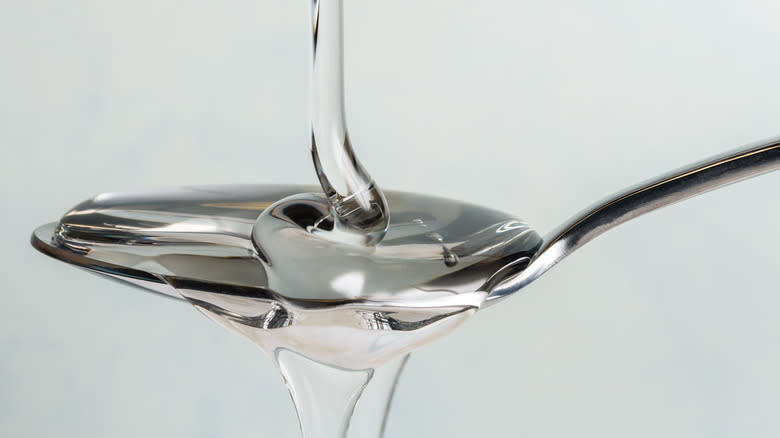
Though golden and corn syrup may look similar in color and texture, they could not be more different in flavor and utility. Corn syrup is produced by refining the starch of predominantly yellow 2 dent corn. In the refinement process, kernels of corn are submerged in a solution of water and sulfur dioxide before getting pulverized into a mash. Once the germ is removed from the kernel, the remaining mill starch is further separated from the protein and cleaned before getting dehydrated into a powder.
This powder is submerged in a hydrochloric acid solution before it is exposed to pressurized heat. The pressurized heat slowly converts the starches into sugars, primarily glucose, before they get filtered, cooled, and packaged. The resulting corn syrup is almost neutral in flavor, yielding a sweetener that does not markedly impact the taste of the recipes in which it is used.
This is one of the main reasons it is favored for certain dishes but makes it most different from golden syrup. The two are similar in their capacity to resist crystallization, ensuring a smooth, grain-free mouthfeel in finished baked or cooked foods. However, they should never be used interchangeably in recipes.
Golden Syrup Versus Honey
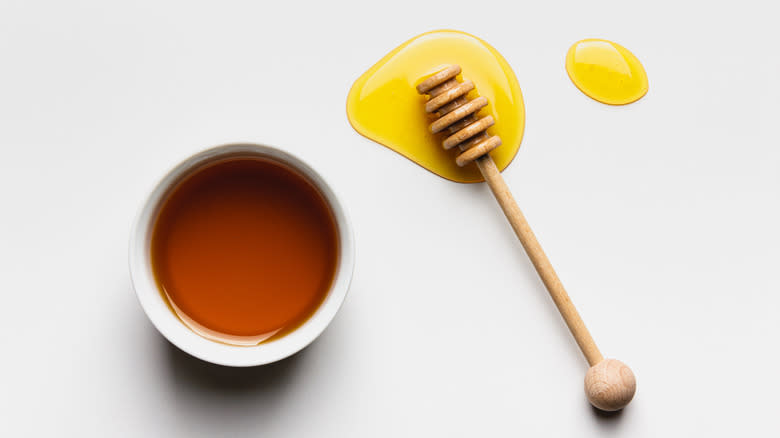
Honey and golden syrup are somewhat more similar in utility and can be used interchangeably in recipes with some adaptations. While both are inverted sugars, golden syrup is inverted through a chemical process, and honey is naturally produced by an enzyme in bees known as invertase. Because of this fact, honey is not considered vegan, while golden syrup is.
Honey is also perhaps somewhat healthier than golden syrup thanks to the antioxidants, vitamins, minerals, and antimicrobial properties within honey, which are absent in golden syrup. Because honey is a naturally produced product, its precise properties can differ from batch to batch, unlike golden syrup, which is manufactured to exact specifications to behave the same whenever added to recipes.
Generally, honey has a lower PH than golden syrup, resulting in somewhat lighter, fluffier baked goods. It also tends to resist moisture absorption, keeping baked goods fresh longer. Lastly, it caramelizes more rapidly than golden syrup, which requires lower baking temperatures and shorter baking times.
Cost and type are factors when choosing honey as a substitute for golden syrup. Most raw honey will cost significantly more than golden syrup. Opt for darker-colored honey, which typically has a more full-bodied flavor, to obtain a similar, rich taste.
Golden Syrup Versus Maple Syrup
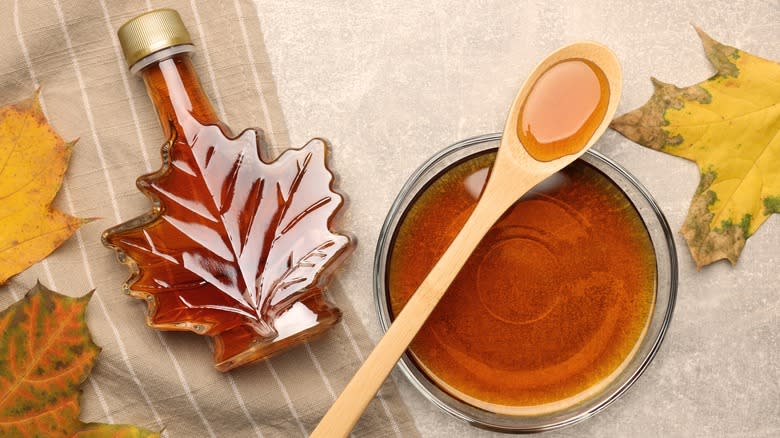
Golden and maple syrup are often mistaken for one another due to their similar viscosity and amber hue. That said, maple syrup's precise thickness and color can vary depending on the grade and type, unlike golden syrup, which is consistent in its color and texture.
While golden syrup is a human-produced inverted sugar product, maple syrup is created by concentrating naturally occurring maple sap. This sap has been collected from sugar, red, and black maple trees and utilized by indigenous populations of North America for centuries. It only became popular among European settlers in the late 1600s.
Maple syrup is known for having abundant vitamins and minerals, such as zinc and magnesium. It also contains less fructose, giving it a lower glycemic index than golden syrup. It differs markedly from golden syrup in its lower levels of fructose, which reduces its capacity to retain moisture, making it far less useful as a preservative. For this reason, golden syrup is the preferred sweetener for commercial applications.
While golden and maple syrup have rich, caramel-forward flavors, they are not interchangeable in recipes, especially baked items. They may be effectively swapped out as drizzling syrups atop pancakes, yogurt, granola, or toast.
Golden Syrup Versus Molasses
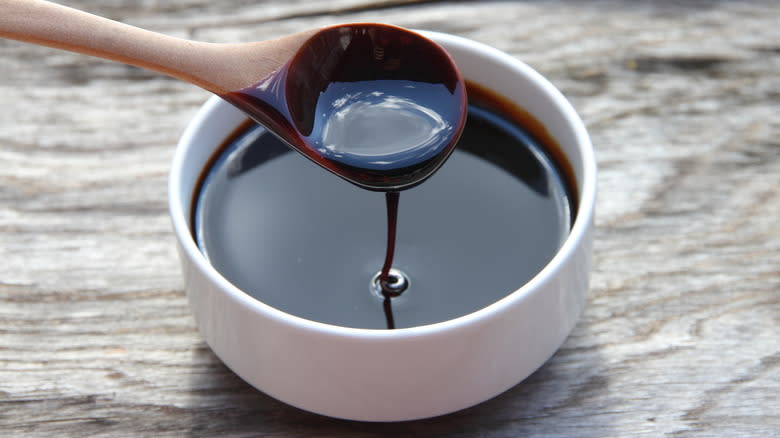
Though golden syrup is called light treacle, it should not be confused with molasses or its British cousin, black treacle. Though all three are byproducts of the sugar refining process, they differ considerably in flavor, color, and applicability.
Both black treacle and molasses are made by reducing the liquid left behind after sucrose has been separated from sugar cane or beet juice. Molasses reduces for far longer, resulting in a lower sugar content, a darker and thicker texture, and a bittersweet flavor that is sometimes almost smoky. These properties make it nothing like golden syrup.
Molasses comes in light, dark, and bootstrap varieties, getting denser and bolder in flavor at each progression. It can also come in both sulfured and unsulfured varieties. Incorporating sulfur dioxide increases its capacity to be used as a preservative in commercial food manufacturing.
Molasses is most commonly added to white sugar to produce brown sugar. It is also a common ingredient in marinades, sauces, and the production of dark beers like a stout. Lastly, it is a potent binding agent, making it ideal for incorporating into the distillation of various alcohols, ethanol production, and the manufacture of animal feed.
How To Cook With Golden Syrup
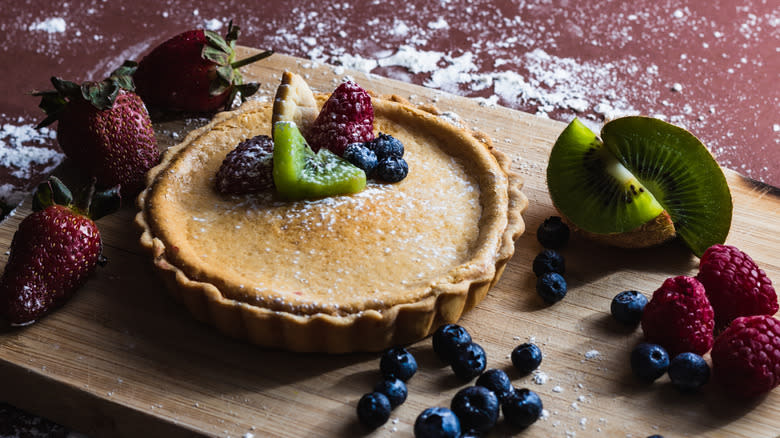
If your first introduction to golden syrup was watching "The Great British Bake Off," you likely experienced this ingredient being fashioned into classic recipes like treacle sponge, treacle tart, brandy snaps, flapjacks, or Anzac biscuits. It can be incorporated into virtually any dessert or baked item that could benefit from its moisture-enhancing properties, rich color, deep flavor, and binding properties.
Golden syrup is also functional as a sweetener drizzled over pancakes, waffles, oatmeal, or fruit. Because of its rich flavor and capacity to dissolve into virtually anything, golden syrup is ideally suited to hot and cold beverages, particularly cocktails. If you want to swap out your simple syrup for something with a more caramel-like robust flavor, look no further than golden syrup. Pairing it with spirits of all kinds can enhance the complexity of your cocktails, balancing the sweet and sour flavors with its sophisticated palate.
Lastly, add golden syrup to temper acidity, enrich the flavors, and help thicken sauces, glazes, or marinades. It is the perfect alternative to sugar, honey, or maple syrup, performing particularly well in chili, barbecue sauce, and even homemade marinara.
Nutritional Information About Golden Syrup
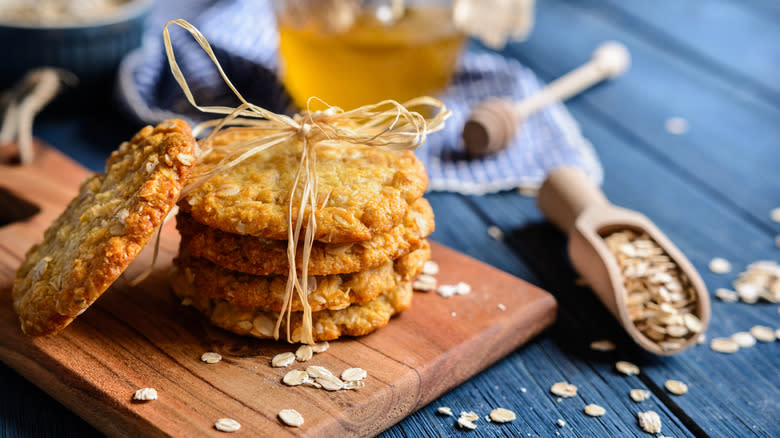
Golden syrup, like sugar, is a refined sweetener made from sugar cane or sugar beet juice. According to Livestrong, the two are nutritionally similar. While both contain equal parts fructose and glucose, in sugar, it is bound, and it is unbound in golden syrup. This does little to change its nutritional profile.
The two are roughly the same in glycemic index, which refers to how rapidly your blood glucose levels will elevate following their consumption. Golden syrup lands at 63, while sugar ranges from 60 to 68. This is considered moderate, with a low glycemic index being foods below 55 and a high one of 70 or above.
Golden syrup has a slightly higher calorie content than sugar, at 60 calories versus 49 per one-tablespoon serving. It also has more carbohydrates per serving at 17 grams versus a little over 12. The difference is not appreciable enough to say one is unequivocally healthier than the other, and both should be considered "empty calories" consumed in moderation.
According to Lyle's Golden Syrup, its products are vegan, gluten-free, nut-free, dairy-free, fat-free, and cholesterol-free. Its syrup is also manufactured without artificial flavors, colors, or preservatives. Lastly, its golden syrup is certified Kosher and Halal.
Where To Buy Golden Syrup
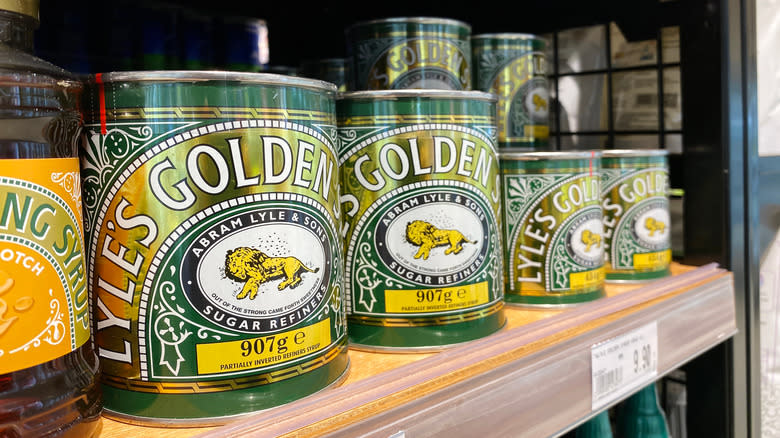
You may find golden syrup in the international sections of some higher-end supermarkets. However, it is more likely that you will find it in gourmet shops that specialize in imported food products. Golden syrup can also be found online and can be purchased from myriad retailers, including Amazon and Walmart.
The syrup comes in numerous quantities from various brands, including the classic Lyle's. Prices vary depending on size and retailer. Many iterations available, including those from Walmart, come in plastic squeeze bottles or glass jars.
Overall, you will likely need to search online to obtain one of the legendary metal tins from Lyle's. You can find them, but they are less readily available and are often sold in bulk. Before you purchase a brand other than Lyle's, read the label carefully, as the term "golden" is sneakily used to describe various types of syrup, from corn to maple, making it easy to misidentify the real deal.
How To Store Golden Syrup
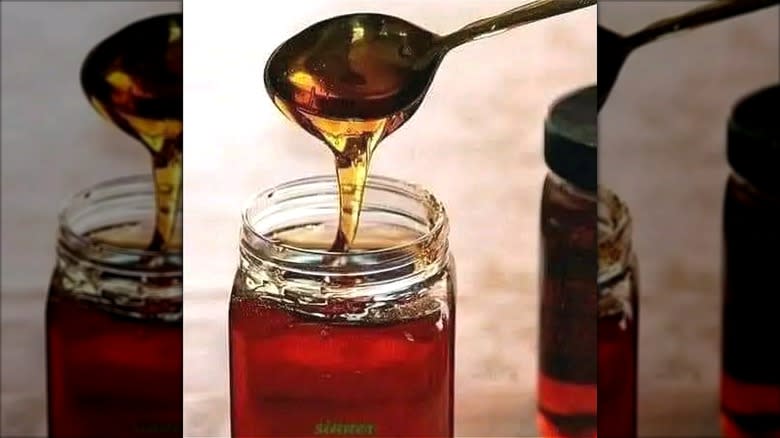
Like many condiments, unopened containers of golden syrup can typically be stored at room temperature for years. Lyle's Golden Syrup recommends you use its product within three months of opening the container. To avoid damaging the texture of golden syrup, store opened containers at room temperature in a cool, dry place away from sunlight or heat, like in a pantry or cupboard.
If you intend to make your own, the syrup should be stored in a heat-proof, sanitized jar that has been tempered with boiling water. Give the syrup plenty of time to thoroughly cool before placing the lid on the jar and sealing it. Once fastened, store the container similarly to the store-bought variety in a cool, dry place away from heat or sunlight.
To avoid cross-contamination, use a clean utensil anytime you scoop directly from the jar. You should also tightly seal the container after each use to prevent attracting any pests or insects.
Read the original article on Daily Meal.

